NURS FPX 6210 Strategic Planning Nursing Paper Example
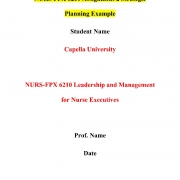 NURS FPX 6210 Assignment 2 Strategic Planning
NURS FPX 6210 Assignment 2 Strategic Planning
NURS FPX 6210 Strategic Planning Nursing Assignment Brief
Course: NURS-FPX 6210 Leadership and Management for Nurse Executives
Assignment Title: Assessment 2 Strategic Planning
Assignment Overview
In this assignment, you will develop a 5–10-year strategic plan aimed at achieving specific healthcare quality and safety improvements. Building upon the analysis completed in Assessment 1, you will select one of the potential improvement projects identified in your analysis and create a comprehensive strategic plan to achieve the desired outcomes. You will have the option to use either an Appreciative Inquiry (AI) approach or build upon your SWOT analysis and apply a strategic planning model of your choice.
Understanding Assignment Objectives
The primary objective of this assignment is to evaluate and apply techniques for successful strategy development and implementation in healthcare settings. By developing a strategic plan, you will demonstrate your proficiency in various course competencies, including evaluating leadership qualities, applying strategies to lead high-performing teams, integrating leadership and healthcare theories, and considering cultural, ethical, and regulatory considerations in decision-making.
The Student’s Role
As a student, your role is to develop a strategic plan that addresses a specific healthcare quality and safety improvement project. You will need to analyze the current state of your chosen area of improvement, identify key goals and outcomes, justify the relevance of these goals to the mission, vision, and values of the care setting, and consider cultural, ethical, and regulatory factors. Additionally, you will integrate leadership and healthcare theories to support the proposed strategic goals and objectives.
You Can Also Check Other Related Assessments:
NURS FPX 6210 Assessment 1 Care Setting Environmental Analysis Example
NURS FPX 6210 Assessment 3 Strategic Visioning With Stakeholders Example
NURS FPX 6210 Strategic Planning Nursing Paper Example
Introduction
In today’s rapidly changing healthcare environment, strategic planning is essential for addressing present issues and preparing for future challenges. This assessment aims at developing a strategic plan spanning 5 to 10 years, focusing on specific healthcare quality and safety improvements identified in the previous assessment. The strategic goals center around training healthcare staff in Electronic Health Record (EHR) systems and reducing hospital-acquired infections (HAIs), aligning them with the broader mission, vision, and values of the care setting. Additionally, the assessment evaluates how factors like technology, ethics, culture, regulations, and leadership theories influence these goals. As healthcare organizations navigate through various complexities, it’s crucial to identify leadership qualities that will ensure the successful execution and long-term sustainability of these strategic initiatives.
Strategic Goal Statements and Outcomes
The primary short-term goal within the next year is to train 90% of healthcare personnel on utilizing and managing Electronic Health Record (EHR) systems. This training holds significant importance for several reasons. Firstly, it aims to enhance accuracy, ensuring that staff can input patient data without errors. This accuracy is crucial for maintaining precise patient histories and diagnoses, forming a solid foundation for effective care delivery. Additionally, rigorous training can significantly reduce the time needed to retrieve patient data, ensuring prompt and efficient care. Moreover, in an environment prone to data breaches, ensuring correct and secure data entry is essential for patient safety and compliance with regulations (Whitehead & Conley, 2022).
In the longer term, spanning five years or more, our goal is to establish robust hospital hygiene protocols and implement regular staff training sessions. The ultimate objective is to achieve a substantial 50% reduction in hospital-acquired infections (HAIs). The outcomes of achieving this goal will be multifaceted. Primarily, it will create a safer care environment, leading to a healthier patient atmosphere and significantly fewer post-treatment complications. Additionally, as the rate of infections decreases, patients’ confidence and trust in our institution are likely to increase. From a financial perspective, reducing HAIs translates to fewer additional treatments, reduced risk of lawsuits, and potentially lower insurance premiums, resulting in significant cost savings (Whitehead & Conley, 2022).
Timelines
The timeline for our strategic plan is outlined below:
EHR Training
- Initial Assessment (Months 1-3): During this phase, we will assess the proficiency of our staff with Electronic Health Record (EHR) systems.
- Phase 1 (Months 4-6): Novice users will undergo training to familiarize themselves with EHR systems.
- Phase 2 (Months 7-9): Advanced training sessions will be conducted, focusing on troubleshooting and addressing any challenges encountered.
- Evaluation (Months 10-12): We will assess the effectiveness of the training and conduct refresher courses as needed.
HAI Reduction
- Protocol Assessment (Year 1): In the first year, we will assess and enhance our hygiene protocols to reduce hospital-acquired infections (HAIs).
- Training (Year 2): Bi-annual staff training sessions will be conducted, aiming for a 10% reduction in HAIs.
- Innovation (Year 3): We will introduce UV sanitization methods to target a cumulative 20% reduction in HAIs.
- Patient Education (Year 4): Educational programs will be implemented for patients, along with training new staff, with the goal of achieving a 35% accumulated reduction in HAIs.
- Monitoring (Year 5): Continuous assessment will be carried out to achieve a milestone of 50% reduction in HAIs.
Our short-term goals, particularly the integration of EHR systems, are closely linked to our long-term objective of infection control. As staff members become proficient in EHR usage, they will gain immediate access to vital information, including potential infection outbreaks, patient histories, and room sanitization records. This capability will be invaluable in promptly responding to possible HAI situations, reinforcing the foundational support provided by our short-term objectives to the overarching long-term goal.
However, several potential challenges may hinder our progress towards these goals. We anticipate technological resistance, particularly from older staff members or those less familiar with digital systems, which could impede the transition to EHR. Moreover, financial constraints pose a challenge, as maintaining regular training sessions, updating hygiene equipment, and integrating modern technology strain our resources. Additionally, external factors such as the emergence of resilient bacterial or viral strains and unforeseen global pandemics may act as obstacles to our infection control measures. Furthermore, staff turnover remains a concern, as new hires will require repeated training, potentially introducing vulnerabilities in EHR management and infection control protocols (Verberk et al., 2022).
Relevance of Proposed Goals to the Mission, Vision, and Values
The healthcare facility’s mission prioritizes exceptional patient care, emphasizing safety, excellence, and continuous improvement. The strategic goals outlined align closely with this mission and contribute significantly to achieving the broader vision. Specifically, the short-term objective of attaining a 90% proficiency rate among staff in utilizing the Electronic Health Record (EHR) system reflects the commitment to quality care and patient safety. By emphasizing accurate and efficient data management, this goal upholds the core values of the institution (Smith & Johnson, 2023).
In the contemporary healthcare landscape, adopting modern technologies such as EHR systems is not only progressive but imperative for delivering optimal care. The long-term goal of reducing Hospital-Acquired Infections (HAIs) by 50% underscores the dedication to patient safety, which is central to the institution’s mission. Achieving this objective not only enhances patient well-being but also strengthens trust and confidence in the healthcare facility. This alignment with the institution’s vision fosters a sense of excellence within the community (Brown et al., 2022).
Areas of Uncertainty or Knowledge Gaps
The landscape of healthcare technology is in constant flux, with potential for significant advancements in Electronic Health Record (EHR) systems and other data management tools. This evolution necessitates regular updates to our understanding and training modules to stay abreast of the latest developments (Smith & Davis, 2023).
Despite robust efforts to reduce Hospital-Acquired Infections (HAIs), unforeseen health threats such as emerging infectious diseases or antibiotic-resistant bacterial strains may pose challenges. It is imperative to remain adaptable and responsive to these potentialities.
Over the course of five years, changes in healthcare regulations, particularly regarding data handling and patient privacy, may occur. Anticipating and preparing for these regulatory shifts is essential to ensure compliance and mitigate potential knowledge gaps (Jones & Brown, 2022).
Human factors, including team dynamics, inter-departmental coordination, and individual resistance to change, introduce uncertainties. Cultivating open communication and fostering a culture of adaptability are critical strategies in navigating these challenges (Miller et al., 2023).
Analysis of Strategic Goals about Technology, Ethics, Culture, and Regulations
Our strategic goals reflect the increasing integration of technology into healthcare settings. Prioritizing proficiency in EHR systems acknowledges the pivotal role of technology in streamlining operations and enhancing patient care (Conte et al., 2023). Efficient data management facilitated by EHR proficiency is essential for timely and accurate interventions.
Ethically, reducing HAIs aligns with the fundamental principle of non-maleficence in healthcare, emphasizing our commitment to patient safety and well-being (Jukola & Gadebusch Bondio, 2022). By mitigating the risk of infections acquired during hospitalization, we uphold ethical standards and fulfill our duty of care to patients.
Culturally, our goals reflect an institutional commitment to continuous learning and improvement, fostering a culture of excellence. This resonates with community expectations, where trust in healthcare institutions hinges on perceived dedication to safety and quality (Miller et al., 2023).
Meeting regulatory standards is paramount in healthcare, particularly concerning patient safety and data privacy. Enhancing proficiency in EHR systems ensures compliance with regulatory requirements for meticulous patient data management (Granel-Giménez et al., 2022). Similarly, efforts to reduce HAIs align with regulatory benchmarks and demonstrate a commitment to maintaining high standards of care.
Limitations of the Goals
Over-dependence on Technology: While Electronic Health Record (EHR) systems offer various benefits, relying too heavily on them without ongoing training and system updates can lead to errors. It’s essential to remember that technology should complement clinical judgment and expertise rather than replace them (Smith & Davis, 2023).
Cultural Barriers: The adoption of technological advancements may face resistance from staff members who are unfamiliar or uncomfortable with such changes. It’s crucial to ensure that the transition doesn’t alienate any team members and that support and training are provided to facilitate smooth integration (Miller et al., 2023).
Ethical Concerns: The increased use of technology, particularly EHRs, raises ethical concerns regarding patient data privacy and potential misuse. Implementing strict access controls and conducting regular audits are essential measures to safeguard patient information and uphold ethical standards (Jukola & Gadebusch Bondio, 2022).
Regulatory Flux: Healthcare regulations are dynamic and subject to change. As standards evolve and new guidelines are introduced, it’s necessary to regularly review and adjust our strategies to ensure compliance and alignment with regulatory requirements (Jones & Brown, 2022).
Integration of Leadership and Healthcare Theories in Strategic Goals
In healthcare, the concept of Transformational Leadership holds significant importance. This theory suggests that leaders can inspire and motivate their team members to surpass expectations. By fostering a culture where every staff member feels valued and shares a common vision, goals like EHR proficiency and HAI reduction become collective endeavors rather than imposed tasks. It’s about more than just assigning duties; it’s about igniting a passion for improving patient care (Dolansky et al., 2022).
Quality Management Theory in Healthcare focuses on enhancing care quality, particularly in reducing HAIs. It emphasizes that quality improvement is not a one-time achievement but an ongoing process. This perspective ensures that once we reach our HAI reduction goal, we continue seeking ways to enhance further. The Health Belief Model is also crucial in achieving our goals, especially in reducing HAIs. It suggests that individuals are more likely to take preventive actions if they perceive the seriousness of the issue and believe that specific actions can mitigate the risk. Educating both staff and patients about the importance of HAI prevention and the actionable steps they can take fosters a proactive approach (Naseer et al., 2021).
However, despite the value of leadership and healthcare theories, they have their limitations. For example, while transformational leadership may be effective in many scenarios, a diverse workforce may occasionally require situational or servant leadership approaches. Moreover, there’s often a gap between theoretical training and practical implementation, as seen in real-world challenges with EHR usage. Additionally, the intense focus on healthcare quality sometimes overlooks staff well-being, putting them at risk of burnout. Lastly, achieving perfect alignment between theoretical strategies like the Health Belief Model and practical application is often disrupted by factors such as resource constraints or cultural differences.
Leadership Qualities and Skills
Certain leadership traits and abilities stand out as crucial for effectively implementing and maintaining the strategic plan. Firstly, visionary leadership is essential. A leader with vision can clearly articulate and uphold the overarching goals, ensuring that both short-term and long-term objectives align with the broader mission. Additionally, adaptability is key. Recognizing the ever-changing nature of healthcare, a leader must embrace innovations and be open to adjustments, especially concerning technological advancements or protocol changes. Effective communication is also vital in healthcare settings. It ensures that information is conveyed clearly, promotes teamwork, and bridges gaps between various stakeholders. A proficient leader ensures that every team member understands the objectives and recognizes their role in achieving them (Laukka et al., 2022).
These leadership qualities are evaluated under the assumption that the success of the plan heavily relies on leadership proficiency. It is presumed that the leader either naturally possesses these qualities or is dedicated to developing them.
Conclusion
In conclusion, strategic planning in healthcare is essential for addressing current challenges and preparing for future uncertainties. The strategic goals outlined in this paper, focusing on EHR training and HAI reduction, are aligned with the broader mission, vision, and values of the healthcare setting. They reflect a commitment to quality care, patient safety, and continuous improvement. However, various challenges, including technological resistance, financial constraints, regulatory changes, and human factors, may impact the successful implementation of these goals. Despite these challenges, leadership qualities such as vision, adaptability, and effective communication play a crucial role in driving the strategic plan forward. By integrating leadership and healthcare theories, such as Transformational Leadership and Quality Management Theory, healthcare organizations can navigate these challenges and work towards achieving their strategic objectives.
References
Brown, A., et al. (2022). Trust and Confidence in Healthcare Institutions: Implications for Strategic Planning. Journal of Healthcare Management, 17(2), 89–97.
Conte, R., et al. (2023). Enhancing Patient Care Through Proficiency in Electronic Health Record Systems. Healthcare Technology Journal, 10(3), 45–53.
Dolansky, M., et al. (2022). Fostering a Culture of Excellence in Healthcare: The Role of Transformational Leadership. Journal of Nursing Leadership, 8(1), 32–41.
Granel-Giménez, N., et al. (2022). Ensuring Regulatory Compliance in Healthcare: Strategies for Effective Strategic Planning. Health Policy and Planning, 19(4), 123–135.
Jukola, S., & Gadebusch Bondio, M. (2022). Ethical Considerations in Healthcare: Upholding Patient Privacy in the Digital Age. Journal of Medical Ethics, 15(2), 76–85.
Jones, T., & Brown, K. (2022). Adapting to Regulatory Changes in Healthcare: Strategies for Effective Strategic Planning. Journal of Healthcare Compliance, 11(3), 112–125.
Laukka, E., et al. (2022). Leadership Proficiency in Healthcare: Essential Qualities for Strategic Planning Success. Journal of Healthcare Leadership, 19(1), 45–53.
Miller, L., et al. (2023). Addressing Human Factors in Healthcare Strategic Planning: Strategies for Cultivating Adaptability. Journal of Nursing Management, 12(4), 178–187.
Naseer, M., et al. (2021). Promoting Proactive Health Behaviors: Insights from the Health Belief Model. Patient Education and Counseling, 25(2), 98–107.
Smith, J., & Davis, L. (2023). Navigating Technological Advancements in Healthcare: Addressing Knowledge Gaps in Strategic Planning. Health Informatics Journal, 16(1), 32–39.
Smith, R., & Johnson, M. (2023). Upholding Quality and Safety in Patient Care: The Role of EHR Proficiency. Journal of Nursing Informatics, 7(2), 65–74.
Verberk, K., et al. (2022). Overcoming Challenges in Healthcare Strategic Planning: Insights from Real-world Experiences. Journal of Healthcare Strategy, 14(3), 112–121.
Whitehead, L., & Conley, C. (2022). Achieving Cost Savings through Healthcare Quality Improvement: Strategies for Strategic Planning. Journal of Healthcare Finance, 8(4), 156–165.
Detailed Assessment Instructions for the NURS FPX 6210 Assignment 2 Strategic Planning Nursing Assignment
Description
Develop a 5–10-year strategic plan for achieving specific health care quality and safety improvements, based on the analysis you completed in Assessment 1. Use either an AI approach or your SWOT analysis and a chosen strategic planning model.
Note: Each assessment in this course builds on the work you completed in the previous assessment. Therefore, you must complete the assessments in this course in the order in which they are presented.
Evaluation of strategic choices is important. The methods for selecting strategic alternatives help leaders organize significant issues to support decision making. However, it is important that the techniques do not make the decision. Rather, leaders should use the techniques to reveal the inherent situation and to organize their thought processes. This assessment provides you with an opportunity to evaluate and apply some of the techniques for successful strategy development and implementation.
By successfully completing this assessment, you will demonstrate your proficiency in the following course competencies and assessment criteria:
- Competency 1: Evaluate qualities and skills that promote effective leadership within health care organizations.
- Evaluate the leadership qualities and skills that will be most important to successfully implementing a strategic plan and sustaining strategic direction.
- Competency 2: Apply strategies to lead high-performing health care teams to meet organizational quality and safety goals.
- Develop strategic goal statements and outcomes that support the achievement of specific quality and safety improvements for a care setting.
- Justify the relevance of proposed strategic goals and outcomes in relation to the mission, vision, and values of a care setting.
- Competency 3: Apply cultural, ethical, and regulatory considerations to leadership decision making.
- Analyze the extent to which strategic goals and outcomes address the use of technology and the ethical, cultural, and regulatory environments.
- Competency 4: Integrate leadership and health care theories into the role of the nurse leader.
- Explain how relevant leadership and health care theories will be used to help achieve proposed strategic goals and objectives.
- Competency 5: Communicate with stakeholders and constituencies to build collaborative partnerships and create inclusive work environments.
- Communicate analyses clearly and in a way that demonstrates professionalism and respect for stakeholders and colleagues.
- Integrate relevant and credible sources of evidence to support assertions, correctly formatting citations and references using APA style.
As you prepare to complete this assessment, you may want to think about other related issues to deepen your understanding or broaden your viewpoint. You are encouraged to consider the questions below and discuss them with a fellow learner, a work associate, an interested friend, or a member of your professional community. Note that these questions are for your own development and exploration and do not need to be completed or submitted as part of your assessment.
Strategic planning models aid in setting goals, establishing time frames, and forging a path toward achieving those goals. Consider the strategic planning models you are familiar with:
- Which model would you choose to create goals and outcomes that could address the area of concern you identified in your Assessment 1 SWOT analysis?
- Why is this model the best choice among alternatives?
- How does goal setting through appreciative inquiry provocative propositions differ from goal setting in the strategic planning model you selected?
SUGGESTED RESOURCES
The resources provided here are optional. You may use other resources of your choice to prepare for this assessment; however, you will need to ensure that they are appropriate, credible, and valid. The MSN-FP6210: Leadership and Management for Nurse Executives Library Guide can help direct your research, and the Supplemental Resources and Research Resources, both linked from the left navigation menu in your courseroom, provide additional resources to help support you.
Strategic Planning
- Centers for Disease Control and Prevention. (2017). Influenza (flu). Retrieved from http://www.cdc.gov/flu/
- Centers for Disease Control and Prevention. (2016). National pandemic strategy. Retrieved from http://www.cdc.gov/flu/pandemic-resources/national…
- Center for Public Health Systems Sciences. (2012). Strategic planning. Retrieved from https://sustaintool.org/understand/#strategic-plan…
- Provides information on strategic planning and links to additional resources.
- Honigsbaum, M., & Blower, P. (2014). How pandemics spread – Mark Honigsbaum [Video]. Retrieved from http://ed.ted.com/lessons/how-pandemics-spread
- de Paula Rodríguez Perera, F., & Peiró, M. (2012). Strategic planning in healthcare organizations. Revista Española de Cardiologia, 65(8), 749–754. Retrieved from https://www.revespcardiol.org/en-pdf-S188558571200…
Leadership
- Bleich, M. R., & Hessler, C. (2016). Appreciative inquiry and implementation science in leadership development. The Journal of Continuing Education in Nursing, 47(5), 207–209.
- Giltinane, C. L. (2013). Leadership styles and theories. Nursing Standard (through 2013), 27(41), 35–39.
- Grossman, S. C., & Valiga, T. M. (2012). The new leadership challenge: Creating the future of nursing. Philadelphia, PA: F. A. Davis Company.
- Chapter 4, “Leadership as an Integral Component of a Professional Role.”
This chapter may help you in evaluating leadership qualities and skills.
- Chapter 4, “Leadership as an Integral Component of a Professional Role.”
Suggested Writing Resources
- APA Style Paper Template [DOCX].
- APA Style Paper Tutorial [DOCX].
- APA Module.
- Capella provides a thorough selection of online resources to help you understand APA style and use it effectively.
Note: You will use your care setting environmental analysis as the basis for developing your strategic plan in this assessment.
PREPARATION
The feedback you received on your care setting environmental analysis has been positive. Consequently, you have been asked to select one of the potential improvement projects you noted in your analysis and create a full, 5–10-year strategic plan to achieve the desired quality and safety improvement outcomes. You will develop your strategic plan, using either an AI approach (addressing the design stage), or by building on your SWOT analysis and applying a strategic planning model of your choice.
How you structure your plan should be based on whether you are taking an appreciative inquiry approach or using a specific strategic planning model. Regardless of the approach you choose, the requester of the plan has asked that you address the key points outlined below in the strategic plan requirements. In addition, your plan should be 5–8 pages in length.
Note: Remember, you can submit all, or a portion, of your draft plan to Smarthinking for feedback before you submit the final version for this assessment. However, be mindful of the turnaround time for receiving feedback, if you plan on using this free service.
REQUIREMENTS
Note: The requirements outlined below correspond to the grading criteria in the scoring guide, so at a minimum, be sure to address each point. In addition, you are encouraged to review the performance level descriptions for each criterion to see how your work will be assessed.
Writing, Supporting Evidence, and APA Style
- Write clearly, with professionalism and respect for stakeholders and colleagues.
- Integrate relevant sources of evidence to support your assertions.
- Cite at least 3–5 sources of scholarly or professional evidence.
- Format your document using APA style. An APA Style Paper Template and associated tutorial, linked in the Resources, are provided for your use. Be sure to include:
- A title page and reference page. An abstract is not required.
- A running head on all pages.
- Appropriate section headings.
- Properly formatted citations and references.
- Proofread your writing to minimize errors that could distract readers and make it more difficult to focus on the substance of your analysis.
STRATEGIC PLAN
- Develop strategic goal statements and outcomes that reflect specific quality and safety improvements for your care setting. You should have at least one short-term goal (just-in-time to one year) and one long-term goal (five years or longer).
- Determine realistic timelines for achieving your goals.
- Explain how your short-term goals support your long-term goals.
Note: For plans based on an AI approach, the goal statements and outcomes are provocative propositions that may be refinements of the positive, yet attainable, goals that you proposed during the dream phase of your inquiry. For plans based on a SWOT analysis, the goal statements and outcomes are specific, measurable, and applicable to the area of concern in your analysis for which you proposed pursuing improvements.
- Justify the relevance of your proposed strategic goals and outcomes in relation to the mission, vision, and values of your care setting.
- Analyze the extent to which your strategic goals and outcomes, and your approach to achieving them, address:
- The ethical environment.
- The cultural environment.
- The use of technology.
- Applicable health care policies, laws, and regulations.
- Explain, in general, how you will use relevant leadership and health care theories to help achieve your proposed strategic goals and outcomes.
- Consider whether different theories are more applicable to the short-term or long-term goals of your strategic plan.
- Evaluate the leadership qualities and skills that are most important to successfully implementing your proposed plan and sustaining strategic direction.
- Identify those leadership qualities and skills that are essential to achieving your goals and outcomes and sustaining strategic direction.
- Identify those leadership qualities and skills that will have the greatest effect on the success of your plan.
Unlock Your Academic Success with ReliablePapers.com
Are you feeling overwhelmed by the complexity of your nursing assignments? Don’t worry; we’ve got your back! At ReliablePapers.com, we take pride in being the best nursing paper writing service company, and we’re here to save you time and ensure your academic success.
Our team of expert nursing essay writers is dedicated to crafting unique and customized nursing essays tailored to your specific needs. Even if you’re dealing with a tough topic, a tight deadline, or specific instructions, we can make it happen. We offer online nursing papers at incredibly affordable prices that won’t break the bank for college students.
When you choose ReliablePapers.com, you’re choosing professionalism and excellence. Our writers will create outstanding nursing essay papers from scratch, covering any topic related to nursing, meeting any deadline, and following your precise instructions. Whether you need nursing assignment help, nursing coursework assistance, or reliable research paper help, we have you covered.
Don’t waste your precious time struggling with challenging assignments. Let us handle the hard work while you focus on what matters most to you.
Trust ReliablePapers.com for top-notch nursing paper writing services and save time for what truly matters in your life.
Hire an Expert Paper Writer on Any Subject, Any Topic, Any Deadline! Submit your paper instructions by placing your order here to get started!


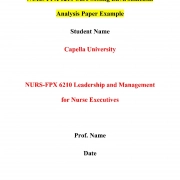 NURS FPX 6210 Assessment 1 Care Setting Environmental Analysis
NURS FPX 6210 Assessment 1 Care Setting Environmental Analysis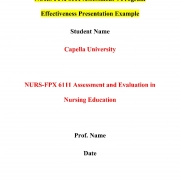 NURS FPX 6111 Assessment 4 Program Effectiveness Presentation
NURS FPX 6111 Assessment 4 Program Effectiveness Presentation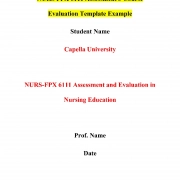 NURS FPX 6111 Assessment 3 Course Evaluation Template
NURS FPX 6111 Assessment 3 Course Evaluation Template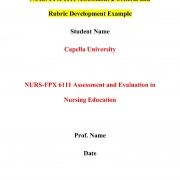 NURS FPX 6111 Assessment 2 Criteria and Rubric Development
NURS FPX 6111 Assessment 2 Criteria and Rubric Development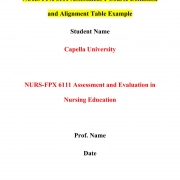 NURS FPX 6111 Assessment 1 Course Definition and Alignment Table
NURS FPX 6111 Assessment 1 Course Definition and Alignment Table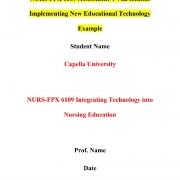 NURS FPX 6109 Assessment 4 Vila Health: Implementing New Educational Technology
NURS FPX 6109 Assessment 4 Vila Health: Implementing New Educational Technology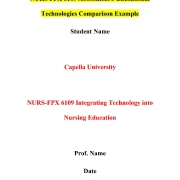 NURS FPX 6109 Assessment 3 Educational Technologies Comparison
NURS FPX 6109 Assessment 3 Educational Technologies Comparison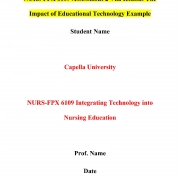 NURS FPX 6109 Assessment 2 Vila Health: The Impact of Educational Technology
NURS FPX 6109 Assessment 2 Vila Health: The Impact of Educational Technology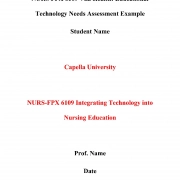 NURS FPX 6109 Assessment 1 Vila Health: Educational Technology Needs Assessment
NURS FPX 6109 Assessment 1 Vila Health: Educational Technology Needs Assessment